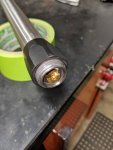Long story, I'll try to keep it short. How much of the brass can stick out of the chamber before the case wall/web that's left unsupported can't handle the pressure and it ruptures?
Is there a hard number not to exceed?
The rifle in question is a Defiance chambered in 6BRa using Lapua brass. The problem arose when the original barrel was replaced with one that had .035 deep chamfer/feed cone cut at the chamber mouth, in addition to the .150 deep bolt nose recess. There was a case failure after the first ~ 30 rounds that blew the bottom of the mag apart. The rupture lined up perfectly with the deepest part of the chamfer. If you look closely at the pic, you can see the brass and where it failed. We sectioned several pcs of the brass looking for signs of case head separation and didn't find anything else that would have lead to this failure.

Is there a hard number not to exceed?
The rifle in question is a Defiance chambered in 6BRa using Lapua brass. The problem arose when the original barrel was replaced with one that had .035 deep chamfer/feed cone cut at the chamber mouth, in addition to the .150 deep bolt nose recess. There was a case failure after the first ~ 30 rounds that blew the bottom of the mag apart. The rupture lined up perfectly with the deepest part of the chamfer. If you look closely at the pic, you can see the brass and where it failed. We sectioned several pcs of the brass looking for signs of case head separation and didn't find anything else that would have lead to this failure.




